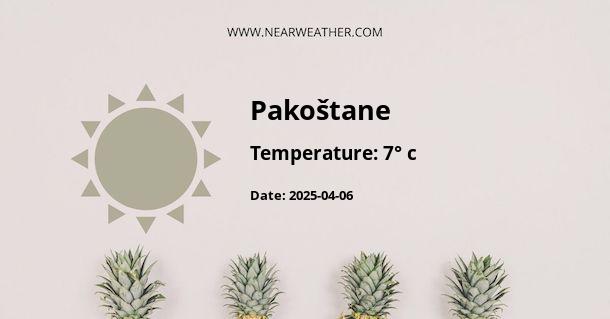Pakoštane, Croatia: A Detailed Look at Its Climate and Year-Round Weather
Situated on the delightful Adriatic coast of Croatia, the charming town of Pakoštane is a hidden gem offering a quintessential Mediterranean climate. Known for its picturesque landscapes, clear blue waters, and temperate weather, Pakoštane has become a cherished destination for tourists and a place of interest for those examining diverse climatic conditions in coastal European environments.
Overview of Pakoštane's Climate
Bordered by both the sea and the Vrana Lake, the largest natural lake in Croatia, Pakoštane enjoys a climate heavily influenced by its geographical setting. Classified as Csa under the Köppen climate classification, Pakoštane experiences hot, dry summers and mild, wet winters.
Temperature Patterns Throughout the Year
Summer: In the summer months, from June to August, temperatures in Pakoštane can soar, often reaching highs around 30°C (86°F). The Adriatic Sea, with its moderating influence, keeps the nighttime temperatures pleasant, generally dropping to a comfortable 18-21°C (64-70°F).
Autumn: September to November marks the transition from the heat of summer to the cooler days of autumn. Average high temperatures in September usually remain warm, around 25°C (77°F), but by November, they dip to cooler 16°C (61°F), with night temperatures falling to 9°C (48°F).
Winter: The winter period, from December to February, experiences the lowest temperatures of the year, with daytime highs around 10°C (50°F) and lows around 3-5°C (37-41°F), rarely dipping below freezing.
Spring: Spring in Pakoštane, from March to May, sees a gradual warming trend with average high temperatures in March at a crisp 14°C (57°F) climbing to a more temperate 21°C (70°F) in May, with the evening temperatures ranging from 6°C to 14°C (43-57°F).
Seasonal Precipitation Patterns
Precipitation in Pakoštane is most plentiful during the autumn and winter months. The area does not receive a significant amount of rainfall in the Mediterranean summer, hence maintaining typically dry conditions during these months.
- Summer: The summer experiences the least amount of precipitation, averaging around 30-60mm/month.
- Autumn: During autumn, rainfall increases, peaking in November with averages up to 120mm for the month.
- Winter: The winter months continue to see substantial precipitation, with December often being the wettest month.
- Spring: As spring progresses, rainfall decreases, leading to the drier summer period.
Wind Conditions and Sea Temperatures
Pakoštane is also subject to local wind patterns that can influence weather conditions, including the 'Bura' - a dry, cold wind from the northeast, and the 'Jugo' - a warmer, moist wind coming from the southeast. Wind conditions can significantly affect both sea and ambient temperatures, as well as the overall experience of the area's climate.
| Month | Average Wind Speed (km/h) | Average Sea Temperature (°C) |
|---|---|---|
| January | 15 | 13 |
| February | 14 | 13 |
| March | 13 | 14 |
| April | 12 | 15 |
| May | 11 | 18 |
| June | 10 | 22 |
| July | 10 | 24 |
| August | 10 | 25 |
| September | 11 | 23 |
| October | 12 | 20 |
| November | 13 | 17 |
| December | 14 | 14 |
Extreme Weather Events and Climate Change Considerations
While Pakoštane generally enjoys a stable Mediterranean climate, extreme weather events such as severe storms or heatwaves can occur. Climate change models predict an increase in the frequency and intensity of these events, potentially impacting local weather patterns long-term. Additionally, rising sea levels pose a threat to coastal communities like Pakoštane.
Climate Data Insights
Weather stations and climate data centers provide detailed information and annual statistics beneficial for understanding Pakoštane's climate dynamics.
- The mean annual temperature in Pakoštane is approximately 15-16°C (59-61°F).
- Annual precipitation averages 750-850mm, concentrated heavily in the colder months.
- Sunshine is abundant, with approximately 2600 hours of clear skies per year.
Climate Adaptation Measures
To address the challenges posed by climate change, local authorities in Pakoštane and the broader Croatian coast are adopting strategies such as coastal defenses, water conservation, and sustainable tourism practices.
Conclusion
Pakoštane's climate, characterized by hot summers and mild winters, makes it an attractive year-round destination. However, it is also a subject of interest given the global context of climate change, necessitating ongoing research and adaptive measures to ensure the region's long-term environmental health and economic stability. For visitors and residents alike, understanding Pakoštane's climate is essential for planning and adapting to the seasonal variety this beautiful coastal town offers.
A - Pakoštane's Latitude is 43.912220 & Longitude is 15.508890.
A - Weather in Pakoštane is 16° today.
A - Climate Conditions in Pakoštane shows clear sky today.
A - Humidity in Pakoštane is 74% today.
A - Wind speed in Pakoštane is 16.09 km/h, flowing at 32° wind direction. today.
